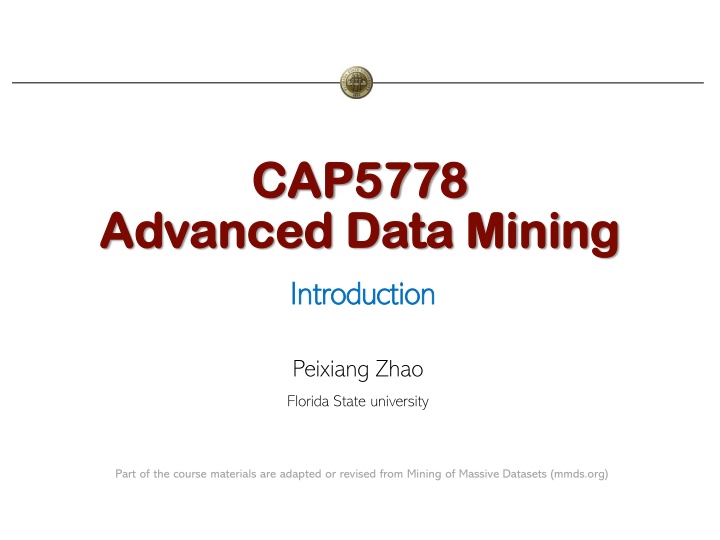
Advanced Data Mining Course Overview at Florida State University
Explore the CAP5778 course in Advanced Data Mining at Florida State University, instructed by Peixiang Zhao. Learn about prerequisites, projects, and the application of data mining techniques to uncover valuable insights from large datasets.
Download Presentation

Please find below an Image/Link to download the presentation.
The content on the website is provided AS IS for your information and personal use only. It may not be sold, licensed, or shared on other websites without obtaining consent from the author. If you encounter any issues during the download, it is possible that the publisher has removed the file from their server.
You are allowed to download the files provided on this website for personal or commercial use, subject to the condition that they are used lawfully. All files are the property of their respective owners.
The content on the website is provided AS IS for your information and personal use only. It may not be sold, licensed, or shared on other websites without obtaining consent from the author.
E N D
Presentation Transcript
CAP5778 CAP5778 Advanced Data Mining Advanced Data Mining Introduction Introduction Peixiang Zhao Florida State university Part of the course materials are adapted or revised from Mining of Massive Datasets (mmds.org)
Welcome to CAP5778 Welcome to CAP5778 Course website: https://www.cs.fsu.edu/~zhao/cap5778/main.html Syllabus, Schedules, Projects, Resources Canvas Announcements, Homework, Grades Textbook: Mining of Massive Datasets (3rdedition) Free online: www.mmds.org The FSU First-day Attendance Policy 1
Welcome to CAP5778 Welcome to CAP5778 Instructor: Peixiang Zhao (zhao @ cs) Research in database systems and data mining Office: LOV 361 Office hours: Tuesday/Thursday right after classes TAs TBA Office hours: TBA 2
Welcome to CAP5778 Welcome to CAP5778 Prerequisites: Data structures, algorithms Probability, linear algebra Programming (C/C++, Python) The programming details won t be covered in this class CAP5771 Intro. to Data Mining is recommended, but not required Structures Lectures, (roughly) 4 homework, project, final exam 3
Welcome to CAP5778 Welcome to CAP5778 Projects: Goal: get early exposure to classic and cutting-edge DM research Format: a group of (at most) three members Select a research topic, and two or three scientific publications from the leading DM conferences/journals, such as KDD, WWW, WSDM, VLDB, SIGMOD, ICDE, The topics need to be approved by the instructor/TA Deliverables: proposals, in-class presentations, and final research survey throughout this semester 4
Welcome to CAP5778 Welcome to CAP5778 Any questions thus far? 5
What is Data Mining? What is Data Mining? Knowledge discovery from databases/data (KDD) Data Information Knowledge Decision-making Data mining is the use of algorithms, machine learning, and statistical analysis to uncover patterns and other valuable information from large data sets Data mining Big Data Predictive Analytics Data Science 6
What is Data Mining? What is Data Mining? Starting from lots of data Discover nontrivial and potentially interesting patterns and models that are Valid: hold on new data with some certainty Useful: should be possible to act on the item Unexpected: non-obvious to the system Understandable: humans should be able to interpret the pattern 7
The Big Data Era The Big Data Era Big Data in Five Minutes. What does Big Data actually mean? 8
The Big Data Era The Big Data Era Data contains value and knowledge 9
The Big Data Era The Big Data Era IDC predicts that by 2025, worldwide data will grow to 175 zettabytes 1021(1,000,000,000,000,000,000,000) bytes, or, one zettabyte is equal to a trillion (1012) gigabytes (109bytes) The end of Moore s law Shrinking transistors have powered 50 years of advances in computing until 2003 improvements in processor performance slowed down: now processing power doubles every 20 years rather than 1.5 10
The Big Data Era The Big Data Era 11
Demand for Data Mining Demand for Data Mining 12
Data Mining Tasks Data Mining Tasks Descriptive methods Find human-interpretable patterns that better describe the data Example: Example: Clustering, frequent patterns, summarization, dimensionality reduction, Predictive methods Use variables to predict unknown or future values of other variables Examples: Examples: Classification, regression, link prediction, similarity search, recommendation, 13
Data Mining: Cultures Data Mining: Cultures Data mining overlaps with: Databases: Large-scale data, simple queries Machine learning: Small data, complex models CS Theory: (Randomized) Algorithms Different cultures: To DB, data mining is an extreme form of analytic processing queries that examine large amounts of data result is the query answer To ML, data mining is inference of models Result is the parameters of the model To Theory, data mining is scalable algorithm design for big data Theory ML DM DB 14
What Matters in Data Mining? What Matters in Data Mining? Usage Quality Context Streaming Scalability 15
Meaningfulness of Analytic Answers Meaningfulness of Analytic Answers A risk with data mining is that an analyst can discover patterns that are meaningless Statisticians call it Bonferroni s principle: Calculate the expected number of occurrences of the events on the assumption that data is random If this number is significantly larger than the number of real instances, you must expect almost anything you find to be bogus they have no cause other than that random data will always have some number of unusual features that look significant but aren t 16
Meaningfulness of Analytic Answers Meaningfulness of Analytic Answers 17
Meaningfulness of Analytic Answers Meaningfulness of Analytic Answers Example We want to find (unrelated) people who at least twice have stayed at the same hotel on the same day 109people being tracked in 1,000 days Each person stays in a hotel 1% of time (1 day out of 100) Each Hotel holds 100 people #hotels (?) If everyone behaves randomly (i.e., no terrorists) will the data mining detect anything suspicious? Expected number of suspicious pairs of people ? Expected number of suspicious pairs of people ? 18
What Will We Learn? What Will We Learn? Mining different types of data High-dimensional, graph-structured, streaming, labeled, Mining using different models of computation Single machine in-memory, data streams, Mining to solve real-world problems Recommender systems, market basket analysis, spam detection, duplication detection and elimination, Mining by different tools Linear algebra (SVD, PCA), optimization (stochastic gradient descent), dynamic programming, hashing (LSH, Bloom filters), 19
How It All Fits Together How It All Fits Together High dim. data Graph data Infinite data Machine learning Apps Locality sensitive hashing Filtering data streams PageRank, SimRank Recommen der systems SVM Community Detection Web Decision Trees Association Rules Clustering advertising Dimensional ity reduction Duplicate document detection Spam Detection Queries on streams Perceptron, kNN 20
Thank you Thank you




